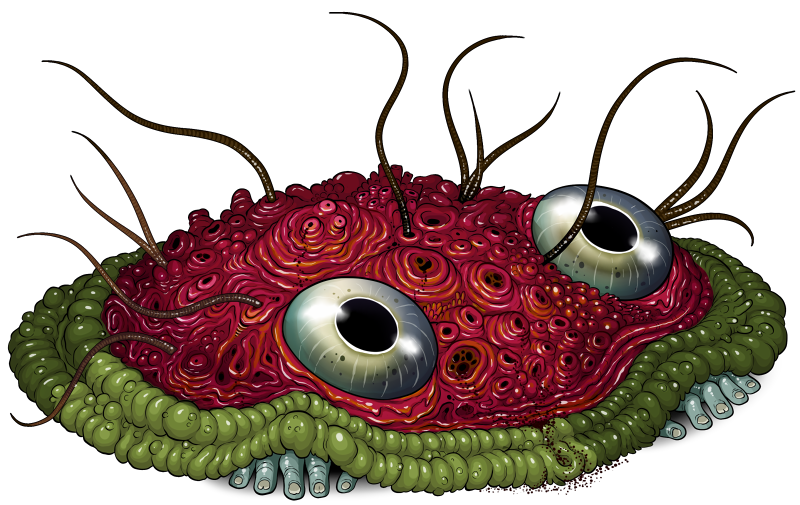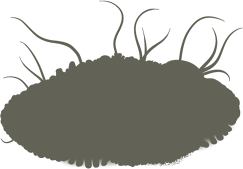|
SCABBERANT  CLASS: BIOCONSTRUCT BIOLOGY: This flattened monster's porous, leathery upper mantle serves as a steady food source and breeding ground for multiple species of symbiotic skin mites ranging from microscopic to nearly pea-sized strains, tunneling hungrily through the mantle's scabrous and calloused crust of scar tissue. Quite skittish, the monster will issue forth millions of its hungry arachnids at the slightest provocation, even scattering a powdery, airborne cloud of infested skin cells by a rapid "shivering" reflex. Larger mites are equipped to penetrate even the toughest of hides as smaller species pour their way inside, causing immediate irritation, pain and rapid tissue degradation to would-be predators. When cornered, the creature may even attempt to envelop an attacker's face in its entire mantle, blinding and suffocating its foe as mites continue to cascade from its spongy flesh. The creature's mantle is an enormous extension of its scalp, the rest its thin, flattened humanoid form adapted to scuttle rapidly over most terrain. Its sensitive nostrils and lipless mouth are turned downward, slurping organic matter into a throat lined with hundreds of grinding plates. An opportunistic omnivore, its fearful nature quickly subsides once the first enticing scraps of skin begin to slough from an infested foe. At least 400 base species and 16,000 subspecies of sarcoptid mites have been identified exclusively from Scabberant, unable to reproduce sustainably in other hosts but mutating and diversifying quickly in the monster's unique flesh. Universal to all specimens are specialized "cannibal" mites that maintain a healthy population balance and "custodial" mites that feed on invasive microorganisms instead of host tissues. In contrast, the underside of a healthy Scabberant is kept virtually sterile by a constant secretion of the same musky oils that also lubricate its eyes. Its mites recognize and avoid only the unique individual musk of their original host, and may turn on it if its surface chemistry is changed too quickly. BEHAVIOR: The Scabberant experiences a constant crawling or tickling as its mites feed, and derives a sense of peaceful security from this sensation. Should it lose its symbionts entirely, it may become fearful enough to bury itself alive and cower from outside stimulus until starvation. If it comes upon another Scabberant in this state of crisis, however, it will not rest until it can drag its fellow Scabberant from hiding, even kicking and screaming, to share a sample of both its mites and its protective musk. Quickly calming down, the restored Scabberant will redevelop its own unique scent and genetically distinct parasites in only days. APPLIANCE: A Scabberant is an excellent bioweapon in conjunction with more physically powerful monsters, its mites quickly weakening and demoralizing tougher adversaries. It may drop on opponents from above, ambush from a narrow hiding space or hide itself under loose substrate like a land mine. It can even cling to the body of an ally like an organic shield, temporarily sharing its immunizing oils. Under extreme circumstances it may submit to being hurled like a weaponized discus, and some individuals grow to find this maneuver exhilirating. The creature must maintain a rich diet and meticulous hygiene regimen to keep its personal biome in sustainable balance, and is consequently a natural expert on dermatological health. Mortasheen's most successful skin care chain is widely recognized by a circular, rotating sign stylized after the monster's two sides, and a respectable franchise location is expected to have a Scabberant working on-site as a consultant. DIREMANGE: contact with the monster's surface or its dandruff cloud transmits an advanced, sometimes life threatening form of scabies infection.   Contents copyright Jonathan Wojcik
|